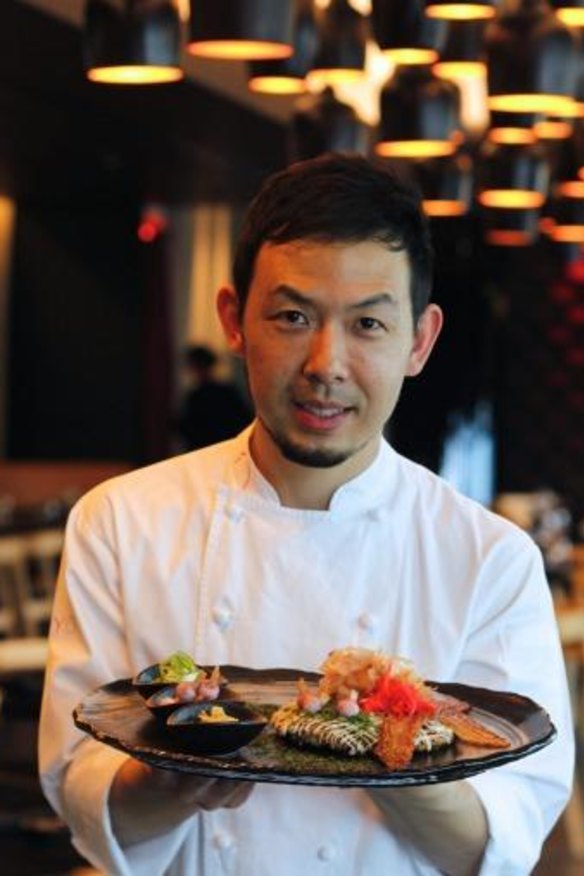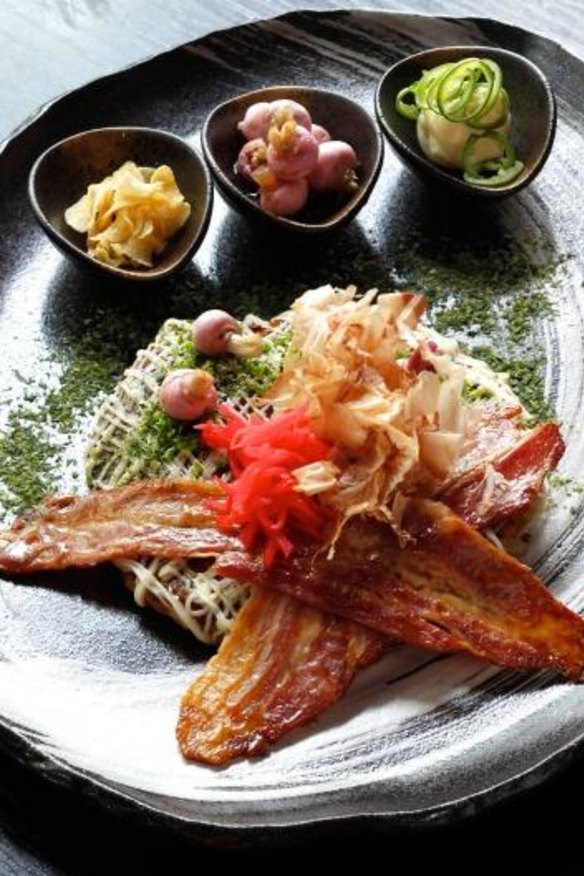How to make okonomiyaki (Japanese savoury pancake)

Scan the menu at Star casino's plush one-hatted Japanese fine-diner Sokyo in Sydney and you'll find delicate creations such as kingfish miso ceviche and Hokkaido scallop with yuzu honey.
But when it comes to people-pleasing comfort food, head chef Chase Kojima turns to a more humble style of dish.
Okonomiyaki is an incredibly popular savoury pancake from Osaka that embodies the best of casual cooking and is great for sharing, Kojima says.
"When I hear okonomiyaki [I think of being] outdoors at night with a lot of lights and a lot of street food," Kojima says. "[It's about] that kind of festival feel."
Kojima says the dish, loaded with vegetables and slathered with sauce and mayonnaise, is also a hit with home cooks and can easily be tweaked to anyone's taste or diet preferences.
"Everybody cooks this at home, so they all have their own style," he says. "It's very easy to make. You don't need any finesse and the kids love it so it's something everybody enjoys."

Kojima's version of this recipe has a few American twists, which he picked up in his home town of San Francisco, where he worked at his father's Japanese restaurant.
Kojima is cooking this dish at Good Food Month's Asia Town street food festival on Sunday, October 19, in Sydney. He shared the recipe and tips with goodfood.com.au.
Equipment
Cooking okonomiyaki doesn't demand much fancy equipment, Kojima says. All you need is a flat cooking surface – either an electric hot plate or a large frypan – and a plastic squeeze bottle with a small nozzle for squirting mayonnaise. If you're keen to add a flourish, look for a squeeze bottle with four nozzles at the end, often available from Japanese variety shops. These squirt ultrafine jets of mayonnaise for that fancy cross-hatch effect.
Ingredients
Finding the ingredients to cook okonomiyaki for the first time will take some sleuthing, but once you've stocked your pantry you're set to go, Kojima says. It's worth making a special trip to a Japanese grocery, which should stock all the ingredients required.
Top of the list is yamaimo. Also known as nagaimo or Japanese mountain potato, this tuber forms an unusual slimy goo when grated, which helps bind the pancake together.
It can be almost impossible to find as a fresh whole vegetable, so save yourself the trouble and head straight to the supermarket's freezer section, where yamaimo can be found pre-grated and vacuum-sealed.
If you must use a substitute, Kojima suggests trying blanched and grated okra, which has a similarly slimy texture. Don't try this trick on a purist, though. "Japanese people say if you don't put yamaimo in it's not an okonomiyaki," Kojima says.
Kojima's recipe also calls for silken tofu, which you can press yourself by squeezing with cheesecloth or similar cloth. This will rid the tofu of excess water and make it crumble into soft chunks.
"By adding the tofu it makes the pancake a little bit more fluffy," Kojima says. "It's like adding ricotta cheese to your pancake – it's that kind of concept."
Kojima prefers using cuttlefish over squid as the latter is easy to overcook, though either is fine. Don't pre-cook squid before adding it to the batter, though. "You don't want it to be chewy," he says.
And if you don't have any dashi on hand, try using dashi powder or any of the commercial dashi sauces known as "tsuyu". If you can't source any of these, a half-cup of water is OK too, Kojima says.
Sauces and condiments
Okonomiyaki is known as much for the toppings as for the pancake itself, starting with the dark sauce slathered over the top. This lends a barbecue flavour, Kojima says, while Japanese mayonnaises such as Kewpie tend to be eggier than Western-style mayos (though both are equally delicious, he says).
Kojima prizes his home-pickled baby turnips for their soft horseradish flavour but says any pickle will help cut through the denser flavours of the pancake. He suggests starting with the pickled red ginger known as beni shoga.
Less traditional is the garnish of streaky bacon and green chilli, which Kojima adds for extra pop.
Apart from the yamaimo, the overall recipe is very forgiving, so there's no need to stick strictly to the ingredients list, Kojima says. There's even a "sandwich-style" Hiroshima version of okonomiyaki cooked with noodles inside.
"If you have extra cabbage or you don't have enough onions or whatever it's not going to make that much of a difference," Kojima says.
Method
Once you've gathered your ingredients the actual method is fairly straightforward, Kojima says. He suggests lightly toasting the baby shrimp on a dry frypan beforehand to enhance the flavour, then mixing the batter with your hands to help bind everything together.
Squirting a dash of sake on the hotplate towards the end of cooking helps pump up the steam and add extra flavour, too.
You'll know when each side is done: the crust is golden and the pancake springs back to the touch, Kojima says. "You want it nice and fluffy," he says.
Spread the okonomiyaki sauce generously over the top ("try to hit every spot so it's nice and juicy"), then dress with mayonnaise and the other condiments.
"I like that moment when the bonito hits the pancake – because it's warm the bonito starts to move like it's alive," Kojima says.
The pancakes are best eaten hot, paired with a sake or beer, but don't worry if you mess up the first one or two. It's all part of the learning process, Kojima says.
"It's not a fussy dish so if it doesn't look perfect nobody cares," he says.
Okonomiyaki (Japanese savoury pancake)
Serves 4
Equipment
Electric hot plate or flat frypan with lid
Plastic squeeze bottle with fine nozzle
Ingredients
150g cake flour or plain flour, sieved
2 whole eggs
50g silken tofu, pressed
300g yamaimo or nagaimo (Japanese mountain potato) grated (from the frozen section of Japanese supermarkets)
½ cup dashi (stock) or cold water
50g spring onion, finely chopped
450g (whole) cabbage, finely chopped
200g cuttlefish or squid, thinly sliced
200g wagyu beef, thinly sliced
Dash of sake
Canola or vegetable oil
Salt
Koebi (dried baby shrimp) – optional
Okonomiyaki sauce
9 parts tomato sauce
3 parts Worcestershire sauce
1 part soy sauce
Condiments (from Japanese supermarkets – serve to taste)
Streaky bacon
Maple syrup (for brushing on bacon)
Kewpie brand mayonnaise
Aonori (Japanese seaweed powder)
Katsuobushi (Japanese dried bonito flakes)
Beni shoga (Japanese pickled red ginger)
Koebi (dried baby shrimp)
Method
Lightly toast koebi in a frypan for a minute or so then set aside.
To prepare pancake batter, sieve the plain flour into a bowl. Crack two eggs into the flour and add yamaimo, spring onion, cabbage, tofu and dashi. Mix together with your hands.
Heat hot plate to medium-high (180°-200°C) and oil lightly.
Season cuttlefish and beef lightly with salt then saute for 1-2 minutes until medium. (If using squid do not saute; chop into small pieces and mix straight into batter.) Allow to cool slightly then mix into the batter, adding a pinch of koebi as well.
Place bacon on an oven tray between two sheets of baking paper and cook in the oven at 200°C for up to 10 minutes until bacon is crispy.
While bacon is cooking, pour 1 cup of batter onto the hotplate. Use a spatula to massage into a 2cm-thick circular pancake. Cover with a lid or bowl and allow pancake to steam for 5-6 minutes.
Using a pair of spatulas or egg flippers, carefully flip pancake, reduce heat slightly and steam for another 4 minutes.
Squirt a dash of sake on to the hotplate under the lid and allow pancake to steam for another minute or so.
Flip pancake a final time and allow to cook for a few more seconds to form a golden crust.
When the bacon is ready, remove from oven, brush with maple syrup and set aside.
For the okonomiyaki sauce, mix your tomato sauce, Worcestershire and soy sauce together in a bowl.
Transfer pancake to a cutting board, cut into quarters and spread the okonomiyaki sauce generously over the top of the pancake.
Using a plastic squeeze bottle with a fine nozzle, squeeze the mayonnaise in a cross-hatch pattern over the top of the pancake. Sprinkle lightly with aonori.
Transfer the pancake to a plate or serving platter. Dress with bacon and remaining condiments.
Sokyo will be serving okonomiyaki at the Asia Town street food festival on Sunday, October 19, as part of Good Food Month. See goodfoodmonth.com.
